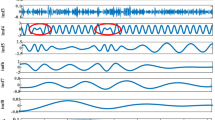Abstract
In a competitive electricity market, wind power prediction is important for market participants. However, the prediction has not a general solution due to its inherent uncertainty, intermittency, and multi-fractal nature. This paper firstly constructs a small-world BP neural network (SWBP) with weight convergence and statistics analysis in order to build a maximum approximation for its nonlinear computation. Then, a modified mutual information (MI) is presented to select the input features for the SWBP, whose selection criteria is to establish the relationship between the numerous candidate features of the input and output associated with the wind power prediction by eliminating the redundant. Thirdly, the improved SWBP based on the modified MI is compared with the BP network upon the 15-min-ahead wind power prediction for performance testing, which includes convergence, training time, and forecast accuracy. Moreover, mean value method is adopted to smooth the volatility of selected input. At last, illustrative examples based on the 4-h-ahead rolling prediction are given to demonstrate its stability, validity, and accuracy of the proposed methodology contrasted with the BP, PSOBP, and RBF neural network algorithms.












Similar content being viewed by others
References
Calif R, Schmitt FG, Huang Y (2013) Multifractal description of wind power fluctuations using arbitrary order hilbert spectral analysis. Physica A 392(2013):4106–4120
Wolf A, Swift JB, Swinney HL et al (1985) Determining lyapunov exponents from a time series. Physica D Nonlinear Phenom 16(3):285–317
Menemenlis N, Huneault M, Robitaille A (2012) Computation of dynamic operating balancing reserve for wind power integration for the time-horizon 1–48 hours. IEEE Trans Sustain Energy 3(4):692–702
Zhang LY, Ye TL, Xin YZ et al (2010) Problems and measures of power grid accommodating large scale wind power. Proc CSEE 30(25):1–9
Zhang ZS, Sun YZ, Gao DW et al (2013) A versatile probability distribution model for wind power forecast errors and its application in economic dispatch. IEEE Trans Power Syst 28(3):3114–3125
Zhang N, Kang C, Xia Q et al (2014) Modeling conditional forecast error for wind power in generation scheduling. IEEE Trans Power Syst 29(3):1316–1324
Ackermann T (2012) Wind power in power system, 2nd edn. Wiley, London
Mohandes MA, Rehman S, Halawani TO (1998) A neural networks approach for wind speed prediction. Renew Energy 13(3):345–354
Kariniotakis GN, Stavrakakis GS, Nogaret EF (1996) Wind power forecasting using advanced neural networks models. IEEE Trans Energy Convers 11(4):762–767
Aggarwal SK, Meenu G (2013) Wind power forecasting: a review of statistical models. Energy Sci 3(1):1–10
Wu ZQ, Jia WJ, Zhao LR et al (2016) Maximum wind power tracking based on cloud RBF neural network. Renew Energy 86:466–472
Heydari A, Keynia F (2015) Prediction of wind power generation through combining particle swarm optimization and Elman neural network (El-PSO). Int Energy J 15(2015):93–102
Watts DJ, Strogatz SH (1988) Collective dynamics of small-world networks. Nature 393(4):440–442
Newman MEJ, Watts DJ (1999) Renormalization group analysis of the small-world network model. Phys Lett A 263(4):341–346
Tripp H, Palmer P (2010) Distribution replacement for improved genetic algorithm performance on a dynamic spacecraft autonomy problem. Eng Optim 42(5):403–430
Perc M (2007) Effects of small-world connectivity on noise-induced temporal and spatial order in neural media. Chaos Solitons Fractals 31(2):280–291
Li SW (2008) Analysis of contrasting neural network with small-world network. In: International seminar on future information technology and management engineering (IEEE), Leicestershire, pp 57–60
Zheng PS, Tang WS, Zhang JX (2010) A simple method for designing efficient small-world neural networks. Neural Netw 23(2):155–159
Simard D, Nadeau L, Kroger H (2005) Fastest learning in small-world neural networks. Physics 336(1):8–15
Yang SZ, Luo SW, Li JY (2006) Building multi-layer small world neural network. Lect Notes Comput Sci 3971:695–700
Li XH, Du HF, Zhang JH et al (2010) Multilayer feedforward small-world neural networks and its function approximation. Control Theory Appl 27(7):836–842
Zhang RC, Li C (2011) Model of NW multilayer feedforward small-world artificial neural networks and it’s applied. Comput Simul 244(10):209–216
Wang SX, Yang CH (2014) Novel small-world neural network based on topology optimization. Control Decis 29(1):77–82
Bao G, Zeng ZG (2017) Region stability analysis for switched discrete-time recurrent neural network with multiple equilibria. Neurocomputing 249(2017):182–190
Bao G, Zeng ZG (2016) Global asymptotical stability analysis for a kind of discrete-time recurrent neural network with discontinuous activation functions. Neurocomputing 193(01):242–249
Wang SX, Tian GB, Yu DL, Lin YJ (2015) Dynamic particle swarm optimization with any irregular initial small-world topology. Int J Swarm Intell Res 6(4):1–23
Zhao X, Wang SX (2014) Convergence analysis of the tabu-based real-coded small-world optimization algorithm. Eng Optim 46(4):465–486
Amjady N, Keynia F (2009) Day-ahead price forecasting of electricity markets by mutual information technique and cascaded neuro-evolutionary algorithm. IEEE Trans Power Syst 24(1):306–318
Cai B (2007) Design method on structure of implicit strata in BP neural network. J Tonghua Teach Coll 28(2):18–19
Robbins HM (1967) A generalized legendre-clebsch condition for the singular cases of optimal control. IBM Corp, Riverton
Shelley Z, Roy CM (1971) Mean square errors of the best unbiased and maximum likelihood estimators of tail probabilities in normal distributions. J Am Stat Assoc 66(335):590–593
Wang LJ, Lei D, Liao XZ et al (2009) Short-term power prediction of a wind farm based on wavelet analysis. Proc CSEE 29(28):30–33
Acknowledgements
This work is funded by National Natural Science Foundation of China (50776005) and supported by China Scholarship Council.
Author information
Authors and Affiliations
Corresponding author
Ethics declarations
Conflict of interest
The authors declare that they have no conflict of interest.
Rights and permissions
About this article
Cite this article
Wang, SX., Li, M., Zhao, L. et al. Short-term wind power prediction based on improved small-world neural network. Neural Comput & Applic 31, 3173–3185 (2019). https://doi.org/10.1007/s00521-017-3262-7
Received:
Accepted:
Published:
Issue Date:
DOI: https://doi.org/10.1007/s00521-017-3262-7




